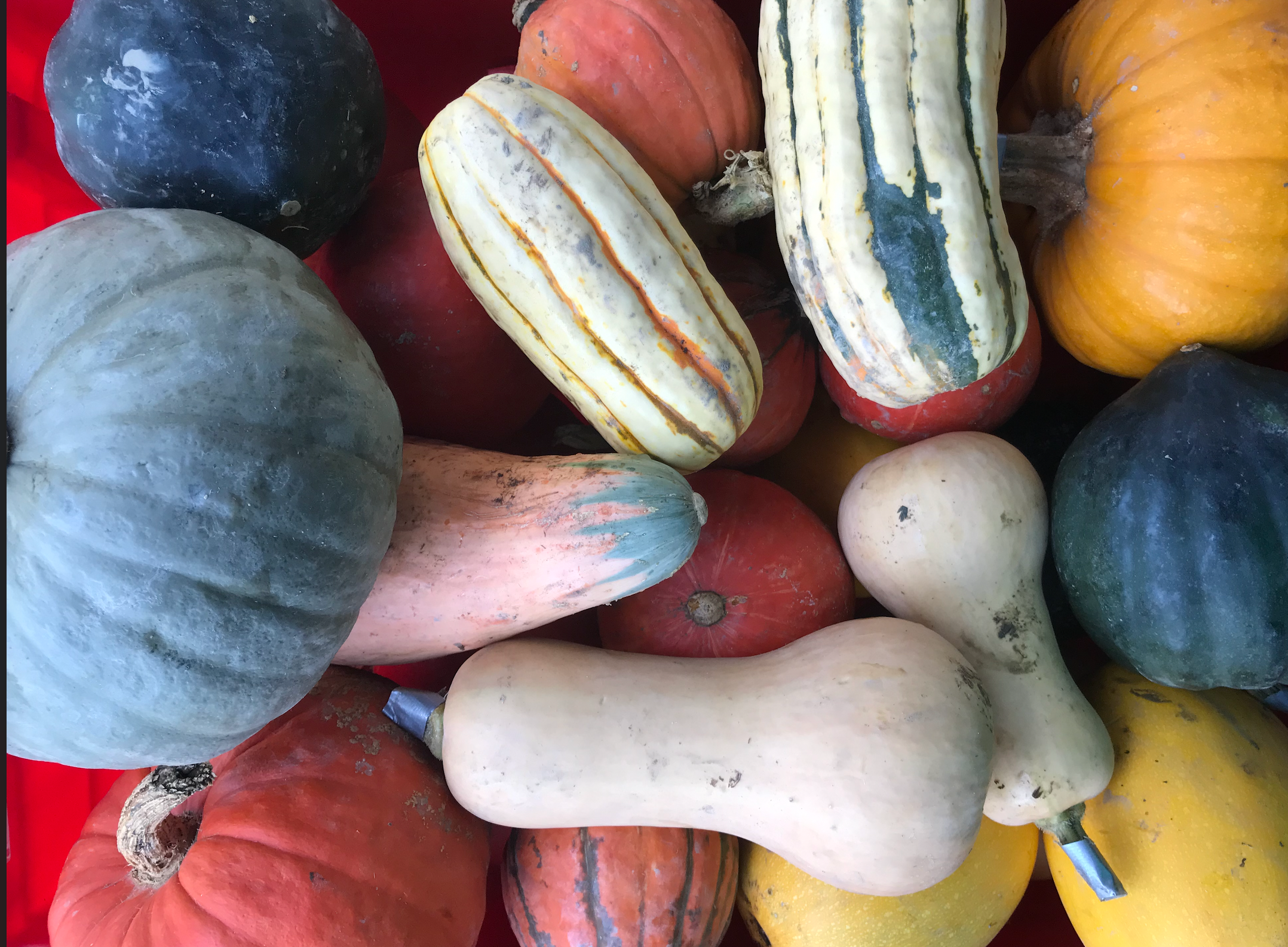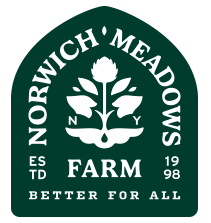Article: A New York Guide to Winter Squash

A New York Guide to Winter Squash
Why late fall is the season for sweetness, depth, and fully cured squash.
As the winter and holidays approach and temperatures drop across Upstate New York, winter squash reaches peak flavor. After harvest, squash is cured—during this time the skins harden and the sugars intensify—so each variety becomes richer, sweeter, and deeply aromatic. For chefs across NYC and home cooks everywhere, this is the moment to bring squash onto the fall and winter table. Below are some of the varieties we grow.
Table of Contents
What Is “Curing” and Why It Matters?
After harvest, winter squash is cured to deepen flavor and extend shelf-life.
- Squash is harvested with a small stem.
- It’s placed in a warm (75–85°F), dry room with good airflow.
- Over 7–14 days, the skins toughen and small wounds heal.
- Inside, starches convert into sugars, giving cured squash its signature sweetness.

Winter squash curing in long rows inside one of our high tunnels.
Winter Squash Varieties We Grow
Butternut
Butternut is the classic winter squash that most people recognize first—reliable, versatile, and endlessly comforting. It’s the squash that shows up in weeknight soups, holiday gratins, and roasted pans of vegetables all season long. When grown well and fully cured, the flesh turns deeply sweet and silky, with a flavor that plays beautifully with everything from brown butter and sage to chili, lime, and tahini.
Flavor & Texture: Smooth, sweet, approachable; a true all-purpose squash.
Best Uses: Puréed soups, sheet-pan cubes, pasta fillings, gratins, and simple roasted halves.
Ragusa Italian Butternut
Ragusa is a rare Italian heirloom that takes butternut to another level, with more complexity and depth. The flesh is drier and more concentrated than a traditional butternut, which means it roasts up beautifully without watering out, and its deep orange interior signals the intensity of its flavor. This is the squash you reach for when you want a dish to really taste like squash—sweet, nutty, and just a bit savory.
Flavor & Texture: Dense, dry flesh with bold nutty flavor and a rich, deep orange color.
Best Uses: Sweet or savory—roasted wedges, gnocchi, savory tarts, galettes, and baked dishes where you want structure.
The Mazourek Line: Honeynut → Honey Patch → Sweet Bea
Row 7 Honeynut
Honeynut is the cult-favorite mini butternut that changed how many chefs think about squash. Developed by three generations of Cornell plant breeders—Michael Mazourek, Molly Jahn, and Richard Robinson—it became a signature variety at Chef Dan Barber’s Blue Hill, where it helped spark a broader conversation about breeding for flavor, not just yield or uniform appearance. Its small size hides an incredibly concentrated sweetness and deep orange flesh that caramelizes beautifully.
At Norwich Meadows Farm, we’ve grown Honeynut for years, and it remains one of the most beloved crops of the season. After curing, its natural sugars intensify, and when roasted the flesh becomes silky, sweet, and almost custard-like. It’s equally at home split and roasted with a drizzle of tahini, puréed into soup, folded into risotto, or served as a simple side with good olive oil and salt.
Row 7 Honey Patch
Honey Patch is the tiniest member of the Mazourek butternut family—almost toy-like in size, but incredibly serious in flavor. Bred by Dr. Mazourek for intensity rather than uniformity, these small squash pack in a remarkable concentration of sugars and aromatics. Their compact size makes them ideal for roasting whole or halved, and they caramelize quickly, developing deeply browned edges and a rich, almost toffee-like sweetness.
Flavor & Texture: Very sweet, dense, and concentrated with exceptional caramelization.
Best Uses: Roasted whole or halved, stuffed squash, skillet slices, or as a centerpiece side for a special meal.
Sweet Bea
Sweet Bea is the largest squash in the Mazourek trio, designed with bakers and dessert-makers in mind. It carries the same rich, complex sweetness as Honeynut but in a larger, more efficient package—so you can make a whole pie or batch of bread with a single squash instead of prepping several. Once roasted, the flesh turns velvety and custard-like, with a flavor that leans naturally toward desserts but also shines in savory applications.
Flavor & Texture: Custardy, velvety, and richly sweet with a deep orange interior.
Best Uses: Pies, cakes, quick breads, puddings, and any recipe where you might otherwise reach for canned pumpkin.
Koginut

Koginut squash, a pumpkin–kabocha hybrid, at our Union Square Greenmarket stand.
Koginut is a pumpkin–kabocha hybrid bred to combine the best of both worlds: the dense, sweet flesh of kabocha with the familiar, comforting shape and versatility of a small pumpkin. When roasted, the flesh becomes smooth and custardy, holding its shape in wedges while still becoming tender enough to mash or purée. Its balanced sweetness works beautifully in both savory and sweet dishes, and it pairs especially well with miso, maple, and warm spices.
Flavor & Texture: Smooth, custard-like flesh with balanced sweetness and good structure.
Best Uses: Roasted wedges with miso or maple, curries and stews, grain bowls, and as a pumpkin substitute in baking.
Delicata
Delicata is the weeknight hero of winter squash—tender, quick-cooking, and incredibly flavorful without any peeling required. Its thin, edible skin turns pleasantly chewy in the oven while the interior becomes sweet and creamy, making it a favorite for busy cooks who still want depth and character on the plate. Sliced into rings or half-moons, it roasts quickly and plays well with everything from bitter greens to citrus and nuts.
Flavor & Texture: Sweet, tender, slightly nutty; with an edible, delicately textured skin.
Best Uses: Roasted rings, sheet-pan dinners, warm salads with greens, and simple side dishes with herbs and olive oil.
Red Kuri

Red kuri squash with their deep red-orange skins and nutty, chestnut-like flavor.
Red Kuri is the squash that often surprises people the first time they taste it. Beneath its vivid red-orange skin is flesh with a distinctly chestnut-like flavor—earthy, savory, and slightly sweet all at once. It purées into a silky, luxurious base for soups and sauces, and holds its own in roasts, stews, and even tempura. Chefs love it for the way it brings both color and depth to a plate without overwhelming other ingredients.
Flavor & Texture: Smooth interior with earthy, nutty, chestnut-like notes.
Best Uses: Soups, miso-roasted crescents, tempura, and purées to accompany fish or roasted meats.
Kabocha
Kabocha is a beloved staple in Japanese cooking and a favorite among chefs who want richness without heaviness. Its flesh is dense and dry, almost cheesecake-like in texture, with a natural sweetness that intensifies when roasted or simmered. It’s equally at home in brothy soups, hearty curries, and simple preparations with miso, soy, or sesame. Once you’ve cooked with kabocha, it’s hard to go back to more watery squash.
Flavor & Texture: Rich, sweet, dry flesh with cheesecake-like density.
Best Uses: Japanese-style curries, stews, miso mash, roasted wedges, and pies or breads that benefit from a dense, flavorful purée.
Black Futsu
Black Futsu is one of the most striking heirloom squash we grow, with deeply ribbed, warty charcoal skin that slowly matures to a dusty, mottled tan. It looks almost ornamental, but inside the flesh is smooth, richly flavored, and lightly floral, with a sweetness that plays well with both savory herbs and warm spices. Sliced into wedges or rounds, it roasts beautifully and makes for a dramatic presentation on the table.
Flavor & Texture: Smooth, rich, and lightly floral with gentle sweetness.
Best Uses: Roasted wedges, grilled slices, composed salads, and as a showpiece squash for festive meals.
Universal Winter Squash Cooking Guides
Roasting Guide
- Cut squash in half or into wedges and remove seeds.
- Coat lightly with oil and salt.
- Roast at 400–425°F until tender and caramelized.
- Finish with brown butter, maple, tahini, chili crisp, vinegar, citrus, or toasted seeds.
Soup Guide
- Roast squash until soft and lightly browned.
- Sauté onion or leek in butter or olive oil.
- Add roasted squash and stock; simmer briefly.
- Blend until silky; adjust thickness with more stock.
- Finish with cream, olive oil, yogurt, or herbs.
Baking Guide
- Roast squash until very soft and caramelized at the edges.
- Blend flesh into a smooth purée and let cool.
- Use in pies, breads, muffins, cakes, pancakes, or custards in place of canned pumpkin.
Winter squash is at its sweetest and most versatile in the cold months, and there’s no wrong way to enjoy it—roasted, puréed, baked, or simmered into soups. If you’d like to cook with these varieties at home, you can find many of them in our seasonal farm boxes and at our farmers markets throughout the fall and winter months.

